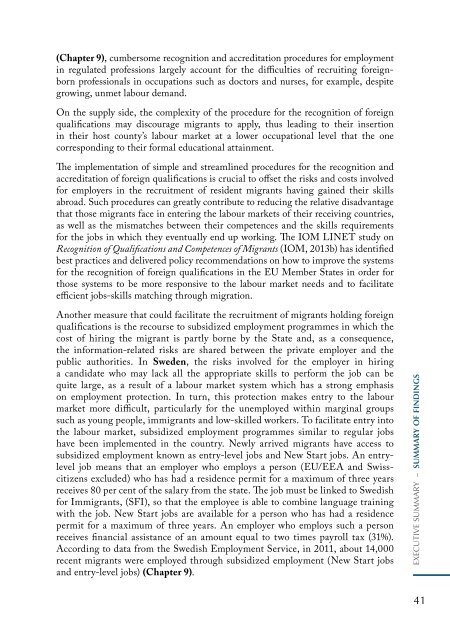International Organization for Migration (IOM)
International Organization for Migration (IOM)
International Organization for Migration (IOM)
You also want an ePaper? Increase the reach of your titles
YUMPU automatically turns print PDFs into web optimized ePapers that Google loves.
(Chapter 9), cumbersome recognition and accreditation procedures <strong>for</strong> employment<br />
in regulated professions largely account <strong>for</strong> the difficulties of recruiting <strong>for</strong>eignborn<br />
professionals in occupations such as doctors and nurses, <strong>for</strong> example, despite<br />
growing, unmet labour demand.<br />
On the supply side, the complexity of the procedure <strong>for</strong> the recognition of <strong>for</strong>eign<br />
qualifications may discourage migrants to apply, thus leading to their insertion<br />
in their host county’s labour market at a lower occupational level that the one<br />
corresponding to their <strong>for</strong>mal educational attainment.<br />
The implementation of simple and streamlined procedures <strong>for</strong> the recognition and<br />
accreditation of <strong>for</strong>eign qualifications is crucial to offset the risks and costs involved<br />
<strong>for</strong> employers in the recruitment of resident migrants having gained their skills<br />
abroad. Such procedures can greatly contribute to reducing the relative disadvantage<br />
that those migrants face in entering the labour markets of their receiving countries,<br />
as well as the mismatches between their competences and the skills requirements<br />
<strong>for</strong> the jobs in which they eventually end up working. The <strong>IOM</strong> LINET study on<br />
Recognition of Qualifications and Competences of Migrants (<strong>IOM</strong>, 2013b) has identified<br />
best practices and delivered policy recommendations on how to improve the systems<br />
<strong>for</strong> the recognition of <strong>for</strong>eign qualifications in the EU Member States in order <strong>for</strong><br />
those systems to be more responsive to the labour market needs and to facilitate<br />
efficient jobs-skills matching through migration.<br />
Another measure that could facilitate the recruitment of migrants holding <strong>for</strong>eign<br />
qualifications is the recourse to subsidized employment programmes in which the<br />
cost of hiring the migrant is partly borne by the State and, as a consequence,<br />
the in<strong>for</strong>mation-related risks are shared between the private employer and the<br />
public authorities. In Sweden, the risks involved <strong>for</strong> the employer in hiring<br />
a candidate who may lack all the appropriate skills to per<strong>for</strong>m the job can be<br />
quite large, as a result of a labour market system which has a strong emphasis<br />
on employment protection. In turn, this protection makes entry to the labour<br />
market more difficult, particularly <strong>for</strong> the unemployed within marginal groups<br />
such as young people, immigrants and low-skilled workers. To facilitate entry into<br />
the labour market, subsidized employment programmes similar to regular jobs<br />
have been implemented in the country. Newly arrived migrants have access to<br />
subsidized employment known as entry-level jobs and New Start jobs. An entrylevel<br />
job means that an employer who employs a person (EU/EEA and Swisscitizens<br />
excluded) who has had a residence permit <strong>for</strong> a maximum of three years<br />
receives 80 per cent of the salary from the state. The job must be linked to Swedish<br />
<strong>for</strong> Immigrants, (SFI), so that the employee is able to combine language training<br />
with the job. New Start jobs are available <strong>for</strong> a person who has had a residence<br />
permit <strong>for</strong> a maximum of three years. An employer who employs such a person<br />
receives financial assistance of an amount equal to two times payroll tax (31%).<br />
According to data from the Swedish Employment Service, in 2011, about 14,000<br />
recent migrants were employed through subsidized employment (New Start jobs<br />
and entry-level jobs) (Chapter 9).<br />
eXecutIve summAry – SUMMARY OF FINDINGS<br />
41


